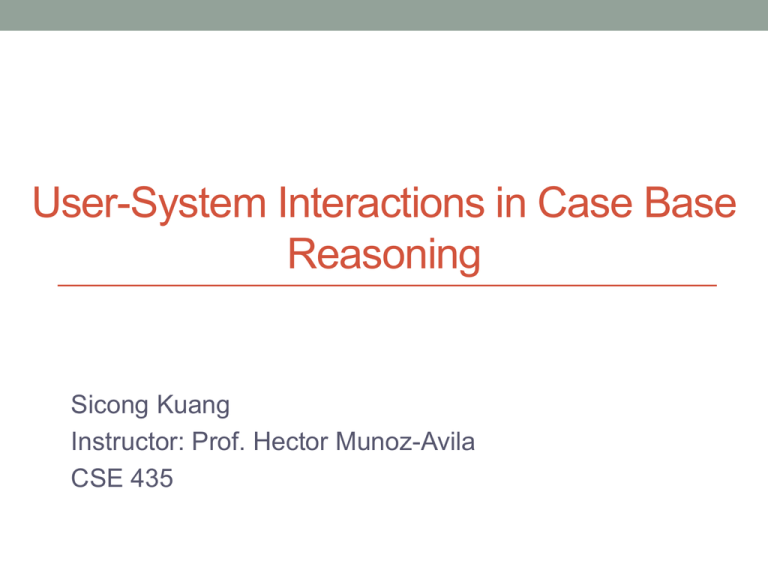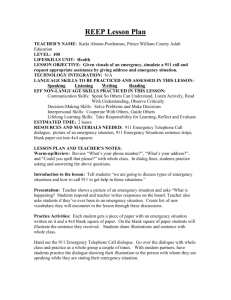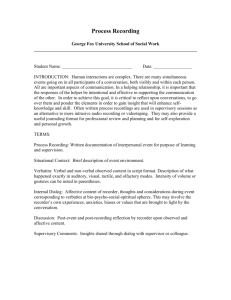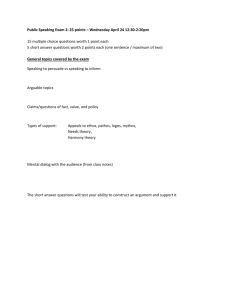SicongKuang - Computer Science & Engineering
advertisement

User-System Interactions in Case Base
Reasoning
Sicong Kuang
Instructor: Prof. Hector Munoz-Avila
CSE 435
Two new communication channels
• The ultimate goal of experience management is to
achieve a communication of experience between an
experience provider and an experience user:
• the communication of the experience provider with the
experience management system and
• the communication of the experience user with the
experience management system.
Two new communication channels
• This communication is of bidirectional nature:
• The
user must be able to tell the experience
management system about his problem.
• The experience management system must be able to
communicate appropriate experience to the experience
user.
• The difficulties involved here are to organize this
communication efficiently and to enable access from
several experience users at a time.
A basic communication architecture
• The communication between the experience user and the
experience management system involves two directions:
• From experience user to the experience management
system during the problem acquisition phase.
• From experience management system to experience
user during the experience presentation phase.
Problem Acquisition Task
• Acquire sufficient information from the user in order to
present to her/him one or several experience items that
are useful to the user for solving the problem
• The difficulties are when (the order) and what should ask,
what should not ask.
• The output of this task should be problems in a known
problem space. We could use input mask
Experience Presentation Task
• Show the retrieved (and possibly adapted) experience to
the user. Formally, this task displays lessons in a known
lesson space in an appropriate way.
• Interactions
between problem
experience presentation task:
acquisition
task and
• The
whole cycle from problem acquisition to experience
presentation is usually executed several times until a satisfying
lesson has been found
• During the iterations, problem description is refined; feedback for
the retrieved cases is obtained
General requirements for user
communication
• The requirements are for both problem acquisition and
experience presentation:
• Small Number of Questions
• Comprehensible Questions
• Low Answering Cost of Questions
• Comprehensible Question Clustering
• Present Appropriate Amount of Information
• Choose Appropriate Presentation Form
• High Interaction Speed
Distribution between Client and Server
side
• Thin client approach
Leave most of the computation on the server side; client
software work load is reduced to minimum. No
installation, no download, but low interaction speed.
• Fat client approach
Move most of the computation on the client side. Good
for experienced user; high interaction speed
• Medium-sized client
Workload distributes evenly. But case data and similarity
measures is left on server side.
A formal dialog model overview
• A dialog can be modeled as a state machine. The state
characterizes a particular instance in time of a particular
dialog enacted between the user and the experience
management.(dialog situation)
• In a given state, a certain set of interactions (with the user)
can be initiated.(dialog interaction)
• There are many different applicable interactions in a
particular dialog. We need a strategy to choose an
optimum one.(dialog strategy)
Dialog Situation
• We define the dialog situation space S= P×Q×H consists
of the problem space P, a question state space Q, and a
hypothesis space H. A dialog situation s = (p, q, h) is an
instance of the dialog situation space, i.e., s ∈ S.
• p is the aggregation of all problem attribute values
collected so far. Initially p is empty.
• q describes the history of the dialog. (finite state variable)
• h contains current hypotheses concerning the reusability
of experience. Usually a subset of the current case base.
Dialog Interactions
• We define the dialog interaction space I= {i1, . . . , ik}
consists of a set of dialog interactions. A dialog interaction
is a function iν : U → (S→ S) that determines from a
certain user input (out of the set of possible user inputs) U
a transformation function of the current dialog situation s
into a successor situation s’, i.e., iν(u)(s) = s’.
• Different kinds of dialog interactions are:
•
•
•
•
Gathering Information
Checking Consistency
Updating Hypotheses
Presenting Experience
Dialog Strategy
• A dialog strategy controls the whole dialog
• A dialog strategy is a function strat : S → I that determines
for a given current dialog situation the next dialog
interaction to be executed.
User-system communication approach
based on the formal dialog model
• Predefined Static Dialog: the dialog interactions and
strategy are manually modeled in advance by the
developer of the experience management system.
• Three-Step Questionnaire-Based Problem Acquisition
Modeling dialog strategy in specific
domain based on the formal dialog model
• Modeling the dialog strategy with a directed graph
• Modeling the dialog strategy with rules
Dynamic and Adaptable Strategies(1)
• Previous static dialog strategies is modeled by hand.
Static means the dialog strategies will not change even
when case base changes.
• To overcome this problem, we want to find a way to
dynamically produce dialog strategy according to the case
base we has.
• The basic idea behind this approaches is to analyze the
distribution of cases in the case base to select questions
according to their relevance for deciding the reusability of
a case.
Dynamic and Adaptable Strategies(2)
• Problem attributes to be asked to users should be
selected according to if they contribute information that is
relevant to decide among the reusability of the cases in
the case base. (a case base with all patients are male)
• Selection criteria for attributes (questions to ask)
• Information gain for classified cases(learned in class)
• Information
gain for unclassified cases: selects k
representative cases, called medoids, and clusters the
other cases according to their similarity to the medoids.
(such as numeric cases)
Using decision tree to implement dialog
strategy(example)
Conclusion
• There are two tasks between the communication between the
user and the experience management system: problem
acquisition and experience presentation.
• A formal dialog model contains dialog situation, dialog
interaction, and dialog strategy.
• Here we use information gain to choose the right question and
the right order to ask; we use decision tree to implement a
dialog strategy.
• Next we will see a practical applications of Case based
reasoning system using a distributed CBR to support field
service.
A distributed CBR Application for
engineering sales support
• Background
• Price of a previous similar installation gave a more
accurate estimation than price giving by personnel
using a proprietary software.
• Solution #1 – a database: 10,000 records, more than 60
fields plus a list of file names for specification.
• Solution #2 – case-based reasoning
Problem with the database solution
• honeymoon period
– initially head office engineers liked it
• then complain…
– too hard to query
– simple queries = too many matches
– complex queries were too difficult
– they browsed the database
– relied on a favorite few dozen projects
solution #2 - a CBR system
• A carefully controlled and monitored trial in need:
• Avoid losing firm money
• Test hardware limitation
• Test on moderately complex residential compared to
high value commercial contracts
• Goal for CBR system
• A system that could find similar installations without
making the query too complex for the engineer(engineer
should expect to involve as less as possible)
solution #2 - a CBR system
• A case-based reasoning system solves new problems by using
or adapting solutions that were used to solve old problems
• Use and adapt old HVAC installations to create new ones
• Base cost estimates on price of similar projects
• Put the system on the web for sales engineers to use
• Increase profit margin
• Increase efficiency
Web-based CBR system
• A web site that sales staff could access anywhere
• Input: Prospect’s requirement
• Output: Similar installation along with FTP address for initial
quote
• Automatically passed back to head office for engineers to
double check the process
• Java: implementation language on server and client side
• XML: communication language for client/server applets.
System Architecture Overview
• Java applet: gather the customer's requirements and send
them as XML to the server.
• Java servlet: On the server side uses input information to query
the database to retrieve a set of relevant records
• The Java servlet then converts the records into XML and sends
them to the client
• Use a nearest neighbor algorithm to rank the set of cases
according to some metric such as similarity
• See system architecture graph in the next slide
System Architecture-Case Retrieval
• Two stage case retrieval
• Stage 1
• retrieve small set (<20) of similar records from database uses
query relaxation
• retrieval is an iterative process
• increases the relaxation with each iteration
• Query relaxation: relax user’s input to ensure a certain
number of useful cases can be retrieved
• Symbolic attribute: relax based on symbol hierarchy.
• Numeric attribute: relaxation is expressed as a term
percentage (e.g., “Relax_Temp = 10% ”)
a
System Architecture-Case Retrieval
System Architecture-Case Retrieval
• Stage 2 retrieval
– use nearest neighbor algorithm (formula below) to calculate the
similarity between the original query and the retrieved records
– allows user to express preferences through feature weights Wi
n
Similarity (T , S ) f (Ti , Si ) Wi
i 1
Where:
T is the target case(retrieved case)
S is the source case(original query)
n is the number of features in each case
i is an individual feature from 1 to n
f is a similarity function for feature i in cases T and S
w is the importance weighting of feature
Lessons learned
• The
initial query relaxation method (performing a
restrictive query and then relaxing the query through
successive iterations until a sufficiently large set of cases
was retrieved ) can cause
error.
• An improved method is to relax the initial query far
enough to ensure that a large set of cases would be
retrieved (e.g., several hundred cases) and then refine the
query to reduce the sub-set to around twenty cases.
Conclusion
• A distributed CBR system can be created in a short amount of time (6
months in this case)
• The system has a ready made case library. Ways to relaxation and
similarity measure have to be configured
• XML is a useful communications protocol enabling large packets of
formatted information to be exchanged thereby reducing network
traffic.
• Further work is planned to investigate the possibility of providing
support or possibly automating some aspects of case adaptation.
• Next we will see how CBR helps General Electric to improve
customer support quality.
Case-based reasoning for General
Electric appliance customer support
• When a customer calls General Electric for help, a call-
taker uses the CBR system to diagnose the problem and
step the customer through its solution
• CBR resulted in an increase in the probability the
customer’s problem can be solved over the phone from
3.9% to 20%
Call center problem
• Call centers provide help to customers who have
questions, problems, complaints, or need assistance.
• However, correctly diagnosing all problems was difficult
because of the following issues:
• The growing complexity of products
• The diagnosis can be confusing
• There is a limited supply of qualified people
• Off-line training is expensive
• Low pay / high turnover (60% per year)
• There needs to be consistency among call takers
• Little or no feedback on failures
The “Support The Customer” (STC)
project
The STC system is just one part of the call-taking process.
The full process is shown in the figure below.
• STC uses a case base to assist the call-taker in helping the customer.
• STC writes information about the diagnostic process to the call record
database.
• Each case includes a description of a problem, solution and a series of
questions to diagnose the problem.
How does “STC” work
1. STC answers as many of the questions as possible
2.
3.
4.
5.
based on the information passed in from the call-taking
system.
According to the STC user interface, the call taker
would provide answers to the questions by the
conversation with the customer.
After each answer is given, the list of potential
questions and results are updated. (results are a list of
possible solutions for the customers problem.)
Step 3 will be recursive until only one result is left in the
list of results.
The solution suggested would be automated sent to
user by email or fax.
Use of CBR
• STC was created using a CBR tool from Inference
Corporation called KnowledgeAgent.
• KnowledgeAgent now is a single search box. It offers
guided help(CBR), user profiles search, keyword and
intent-based search, natural language processing.
• STC is a mixed initiative conversational CBR system that
acts as an intelligent assistant for the call taker. But the
natural language processing still relies on the call taker.
Mixed initiative system
• STC represented by the Agent and the user in the figure
below, will take the initiative alternatively. This scheme
greatly release the burden of the call taker and accelerate
the process speed.
Conversational CBR(CCBR)
• A problem solving technique that is used when all the
information needed to solve a problem may not be
available at the beginning of the problem solving process.
For example, users can not provide a complete
description of the problem at the very beginning.
• In CCBR,
a query describing a target problem is
incrementally elicited in an interactive dialog with the user,
often with the aim of minimizing the number of questions
the user is asked before a solution is reached.
Conversational CBR(CCBR)
• The initial query is based on user’s brief description in
free text.
• In each dialog cycle, the user is shown any cases with an
above-threshold similarity to the current query.
• Dialog is terminated when the user find the case that can
solve his problem, or some predefined termination criteria
is satisfied, such as the max dialog cycle is reached.
Use of CBR in STC
• Two kinds of cases:
• abstractions of a class of problem that may have taken
place many times in the past and
• hypothetical cases of problems that may take place in
the future.
• Each case has title, description, set of questions, solution
and attachment.
• In order to ease the effort of case collection and
maintenance, use decision tree in organizing and
classification of cases.
• Next slide shows a decision tree that was created for
organizing the refrigerator case base.(using Visio)
Use of decision tree in classification of
cases
Application Development and Deployment
• The development of the STC system was a five-step
process.
1.
2.
3.
4.
5.
Standardize the process and knowledge: determine the
correct questions to ask and the correct order to ask (last
slide).
Digitize the inputs and outputs so that we can process a
large mount of data quickly.
Automate the process as much as possible: call taker or
agent should involve as less as possible.
Control the quality of the system
Leverage the system and knowledge for improved impact:
the system is not only benefited by call takers. Users
schedule their own field service through GE’s web site
Maintenance
• One full time case author and forty part-time technician.
• Regular updates are now released monthly.
• Special updates from new products or important updates
to existing products take place at needed intervals, but
these are less frequent than the regular updates.
Conclusion
• GE’s “Support The Customer” project utilizes CBR to help
call takers to query the customer and acquire information
to make a better and quicker diagnosis of the possible
results.
• STC is a mixed-initiative conversational CBR system.
CBR and user together elicit the possible solution for the
proposed problem.
Summary
• We discuss the two tasks in user-system interactions in
case based reasoning.
• To complete the two tasks, we introduce a formal dialog
model. We conclude that the process of case based
reasoning is a series of recursive dialog cycles until a
termination criteria is satisfied.
• We analysis two CBR applications. How GE use CBR to
help their call takers to support the customers. And how a
distributed case based reasoning system is implemented
by Western Air Ltd.
Reference
• Conversational Case-Based Reasoning – David Aha,
Leonard Breslow, Hector Munoz-Avila, Sept 1999
• Experience Management – Ralph Bergmann
• Case-Based Reasoning for General Electric Appliance
Customer Support – William Cheeetham
• A Distributed Case-Based Reasoning Application for
Engineering Sales support – Ian Watson, Dan Gardingen
• Any questions?
Backup slides
Recall: information gain
• Criteria for attribute selection
• Recall: information gain
• The information content expected in a correct answer:
I(p/(p+n),n/(p+n))
Bits of information to classify an example after testing attribute A:
Reminder(A) = p(A,1) I(p1/(p1+ n1), n1/(p1+ n1)) +
p(A,2) I(p2/(p2+ n2), n2/(p2+ n2)) +…+
p(A,v) I(pv/(pv+ nv), nv/(pv+ nv))
The information gain of testing an attribute A:
Gain(A) = I(p/(p+n),n/(p+n)) – Remainder(A)





